Troubleshooting Problems
Involving Engine/Shaft Alignment
by David Pascoe
When it comes to yacht maintenance, one of the least understood and most overlooked systems that require maintenance, engine and shaft alignment probably heads the list.
Damages caused by Engine/Shaft Misalignment
Here's a short list of the problems associated with incorrect alignment and poor or worn out engine mounts:
- Rapid bearing wear.
- Causes stuffing boxes to wear out and leak, not infrequently sinking the boat.
- Bent or broken shafts
- Drive system vibration that can damage transmissions, engine mounts and the boat hull itself.
- Transmission failure caused by increased stress on the rear output shaft bearings and gears.
- Loosening of struts, causing leaking and possible sinking.
- Oscillating propeller shaft causing stuffing box clamps to loosen and work free, usually sinking the boat.
- Wear or worn out engine mounts cause drive shaft misalignment to stern drive, causing universal joints to oscillate and wear out.
Reasons Causing Damages
These are but a few of the damages that can be caused by basic engine/shaft misalignment. Now comes a discussion of why, unlike in an automotive applications, boat engine drive systems do not indefinetly remain in alignment and need to be periodically checked and realigned. People tend to think of boats and yachts as being rigid structures, but they're not. The fact is that boats bend and twist in all directions, albeit not to any degree that's visually detectable. Expecially fiberglass boats, because they are a thermosetting plastic, can change their shape over time. This can happen either as a result of improper hauling and shoring, or it can happen simply as a factor of age and the effects of gravity.
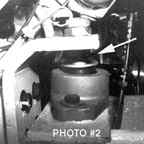
This type of mount is fine for gas engines but not for heavy diesels. This mount, on a brand new 45 footer, is badly distorted. Note how it is cocked toward the engine and forward. In this case, the mounts allowed the engine to move so much that the shaft coupling came apart.
However, the primary reason why drive systems do not stay in line indefinitely is due to wear and tear on all the components that make up the system. Stress, vibration, friction, slamming and pounding are all factors that contribute the the changing size and shape of all physical objects. Foremost among these are the engine mounts. Remember that it is the engine mounts that carry nearly all of the thrust load of the propeller and transfers it to the hull. Obviously, then, the engine mounts should be well-designed and strong. Unfortunately, more often than not the builder has selected the most inexpensive mounts that he can buy, mounts that are not going to do a very good job of keeping the system in alignment.
In fact, the most commonly used engine mounts for gas and small diesels is a mount that does a very poor job of maintaining alignment. Shown in the photo above, this mount not only permits the engine to rock forward and back, but up and down and laterally also. It literally allows the engine to move like a hobby horse.
A basic rule in engine alignment system is that that larger the vessel, the longer and larger diameter the shaft, the more critical alignment is. That's because any misalignment becomes magnified over the length of the shaft; the longer the shaft, the greater the potential error. A shaft that's centered at the strut bearing can easily be off by several inches with only a change in a degree or two of angle at the engine. This factor is what accounts for why shaft misalignment can cause so much damage on any shafting system of considerable length.
This is also why small boats can get away with a great deal of misaligment, and why they can get away with using cheap, inferiror mounts. A shaft that is only ten feet long can tolerate ten times the amount of misalignment of a shaft that is twenty feet long. But by the time you get up to a fourty-footer with a 15' shaft, the amount of movement and misalignment in the system that it can tolerate without causing damage declines dramatically.
At this point, the thickness and mass of both the shaft, propellor and the drive load all begins to play an increasingly important role. The reason is simply because small diameter shafts are much more elastic than large diameter shafts. All boat shafting systems are self-centering to some degree, but the larger the diameter shaft, the less self-centering it becomes. The shaft does not bend but transfers all that misdirected energy (vibration) to other components such as struts, bearings, transmission and the engine mounts.
How to Check Your System
-
The first thing to do is to check the engine mounts. If they are the vertical stud type set in a rubber base, these are the kind that are prone to rocking back and fourth. Check the stud to make sure that its centered in the base with the vessel at rest. If its leaning in any direction, the mount is stressed and the system is out of alignment (see photo #2).
-
Conduct a back down test. One engine at a time, start from neutral, put the engine in gear and accelerate hard, up to no more than 1/3 throttle. Repeat this process in reverse, all the while watching the mounts for movement. If the engine and mount are moving more than 1/8" in any direction, your mounts are not doing their job of holding the engine in place.
-
Observe the shafts while running at two speeds, idle and cruise. Observation of shaft runout will only prove the negative; out of line shafts can appear to run true even though out of line. On the other hand, a badly wobbling shaft means something's wrong. Runout up 1/8" is acceptable at idle speeds but not at cruise. If shaft wobble is visible over 1200 RPM, suspect a problem. Again, that's becasue rotating shafts tend toward self-centering. At high speed enven bent shafts can straighten out and show no sign of trouble. If the shaft is observably causing the transmission to move, or you can feel the movement by putting your hand on it, then there's definitely a problem.
-
Many boat yards think that the way to check shaft alignment is to disconnect the coupling and check the flange clearance with a feeler gauge. That's only part of the story. Before doing this, with the vessel hauled, check the position of the shafts relative to the bearings. Cutless bearings that are worn more on one side than another are a positive indicator that something is out of alignment. Heavy shafts of 1.5" or more will naturally compress the rubber bearing on the bottom side, but not so much that there's an obvious gap at the top. Photo #1 illustrates a clearly misaligned shaft.
-
Next, check the shaft-to-bearing alignment at both the front and back ends of the bearing. If the shaft is off-centered, either to one side, top or bottom at one end, but is off-centered to the opposite side at the other end, then the shaft is not parallel with the bearing bore. It is either up or down, or off to one side. In this case, the whole system should be suspect, at which point the entire system alignment must be redone, including setting up target wire to make sure that the struts themselves are properly aligned.
-
Now check how the shaft is centered with the opening in the stuffing box flange. If there is little clearance (shaft in the opening), it should be exactly centered; if a lot of clearance, it can be off a little without causing harm.
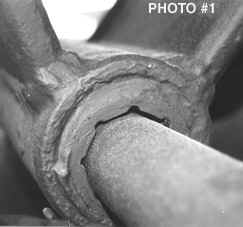
Judging by the large gap at the top, this bearing looks like it is worn. Actually it is new but the shaft is badly misaligned with the strut. This is determined because the gaps are on the opposite side of the bearing at the front side of the strut. Thus, the shaft is "cocked" in the bearing.
When there is significant misalignment involved, the struts and strut bolts should be checked. To do this, I usually pick a heavy piece of shoring found in most boat yards and give the strut several good whacks. If the strut deflects or shudders, its not stable. If water squirts out from the base, its loose. Also note whether the whole bottom of the hull is defecting when you hit the strut. If so, there's no point in realigning anything unless you first do something to make the strut base stable. If the struts are fluttering because the bottom is weak, the entire system is unstable and must be corrected.
Dial Indicating Shafts
Recently a number of articles have appeared in boating publications about dial indicating shafts while in the boat. I'll explain why this should never be done. As noted above, boat hulls can and do change shape over time. Further, the shape of the hull changes when hauled versus afloat. The changing shape of the hull is likely to cause the shaft to bend. Now, you may look at a 1.5" stainless shaft and think that it's cannot be easily bent. In fact, if you suspend it on its ends, even gravity will bend it considerably. Gravity will bend a 15' shaft a lot.
Finally, when you rotate the shaft by pulling on the propeller, you're moving the shaft against the rubber bearing, further throwing your dial indicator readings off. As any trained machinist will tell you, there's only one way to dial a shaft and that is on a calibrated roller bed. One simply cannot dial a rotating object without a reference base and expect accurate results. And a shaft in a boat doesn't provide such a reference.
Only after all the above checks have been made and proven that all else is in order, should one then procede to use the feeler gauges on the coupling. The problem with using feeler gauges is that this measurement can give a false indication that all is well. Particularly smaller shafts can be out of alignment at one end and yet still give a favorable reading at the coupling end. This is because shafts with multiple bearings can bend it into a favorable position while overall it is still badly out of alignment.
Weak Struts
This is a very common problem on small to midsize boats. If you want to understand just how important strong struts are, just take a look at the huge struts used on larger Bertrams, Hatteras or Viking yachts. They don't spend all that money on massive struts for no reason. When there are hundreds of thousands of dollars at stake in machinery, the drive support system must be strong.
A futher fact to consider is that the smaller and less the value of the boat is, the less the amount real engineering has gone into its design. The drive system is one area that is often shortchanged.
Take a close look at the strut arm length to strut base ratio. Or, in otherwords, the ratio of the base footprint to the strut length. Also look at the strut width and cross-sectional thickness. In photograph #3, notice how long the strut arm is and how narrow the width is. The arm to width ratio is over 3:1 while the length to base ratio is more that 2:1. The extreme amount of leverage that the arm applies to the base means that it can't possibly hold the shaft steady. It will deflect and allow the shaft and propeller to oscillate.
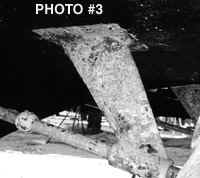
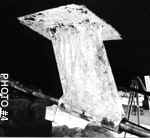
The strut in photo #3 carries the same size shaft and prop as in #2, both on a 40' boat. But the later is double the thickness in both width and cross-sectional area, with a substantiallly wider base. There is no doubt that this strut will hold the shaft steady. Also notice that the length of the strut bore is double the length of that in photo #2.
This strut will hold the shaft very steady, and because of this, correct engine/shaft alignment is much more critical. If its not correctly aligned, something will have to give, and whatever that is is likely to be expensive. The same holds true for shafts with double struts. In fact, a double set of struts will hold a shaft in even closer tolerance. As a general rule, shafts under 1.5" tend to be self-centering because they will bend so some small degree. But shafts larger than this do not take well to bending. They will not bend but work to tear the system apart if not correctly aligned.
Another general rule is that the larger the shaft diameter and the more bearings it has, the more critical are the engine mounts. Unless the mounts are holding in the engine in place and not permitting any movement, there's no point in trying to achieve proper alignment of anything. If the engine moves, no other part of the system will stay in alignment either.
Still another source of engine mount, strut bearing, vibration and shafting problems results from engines that are mounted on weak stringers, or on a hull bottom that is flexing. There are literally thousands of boats that have this problem. During the course of sea trials I frequently encounter engines that are shuddering and bouncing around to such a degree that the entire drive system is being damaged, from engine mounts all the way back to the strut bearings.
Engines mounted on weak stringers frequently results in transmission failures. This is because the worse part of the misalignment is being absorbed by the transmission coupling and output shaft bearings. The problem is usually blamed on the transmission when the source of the problem is really the hull itself. For boats that have had a history of transmission failures, this is something that should be checked first, before blaming the machinery or faulty repairs.
Only after checking all of the above points and making sure that all is in order should the transmission to shaft coupling alignment be checked.
Posted in 1997
 Visit davidpascoe.com for his power boat books
Visit davidpascoe.com for his power boat books 


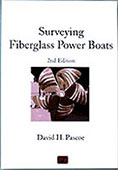












David Pascoe is a second generation marine surveyor in his family who began his surveying career at age 16 as an apprentice in 1965 as the era of wooden boats was drawing to a close.
Certified by the National Association of Marine Surveyors in 1972, he has conducted over 5,000 pre purchase surveys in addition to having conducted hundreds of boating accident investigations, including fires, sinkings, hull failures and machinery failure analysis.
Over forty years of knowledge and experience are brought to bear in following books. David Pascoe is the author of:
In addition to readers in the United States, boaters and boat industry professionals worldwide from nearly 80 countries have purchased David Pascoe's books, since introduction of his first book in 2001.
In 2012, David Pascoe has retired from marine surveying business at age 65.
On November 23rd, 2018, David Pascoe has passed away at age 71.
Biography - Long version